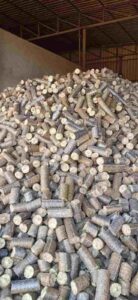Biofuels Junction Grew 10 fold Since 2019; Fleet On Street Our Biggest Strength: Ashvin Patil
 Ashvin Patil Biofuels Junction CBG biogas
Ashvin Patil Biofuels Junction CBG biogas
Tell us about the journey so far for Biofuels Junction.
Ashvin Patil: The journey of Biofuels Junction has been great. We have grown not only in terms of financial aspects but also in learning also. We have successfully implemented our model and now geared up for future growth given the opportunities are so big. Presently, there is no company having pan India presence, no strong supply chain and no model to follow. For us it was like trying different models and now we have arrived at a particular model which is now an example in supply chain. For future growth we are also focusing on IT-enabled supply chains. In our journey we realized that because agricultural residue is weight loosing, it was a challenge to supply raw materials to projects beyond 40-50 km range. A single manufacturing plant in a radius of 50km is viable. The effect of this is that plants are small in size and their scalability is constrained by the cost of raw material. That’s why small units are scattered across the country. The demand is scattered and so is supply which is not organized. There is not a single player in the value chain that can supply the required quantity of raw material. One location would have large demand, others may not. In our journey, we realized this when we were actually operating some of the plants on our own. Since a plant is not scalable, it’s always viable to have some manufacturers aggregated at one location. We have put up two things –fleet on the street and an IT-enabled platform. Financially we have grown 10 fold since 2019. We are operating a prudent model just to ensure that we are profitable and don’t burn cash. We are a strong team of 45 people which are employed across the supply chain. We have presence at all key supply chain locations of India – Chennai, Lucknow, Ahmedabad, Howrah, etc.
You are into residue collection, briquettes and pellets making. The supply side has emerged as the most challenging part of the biofuel industry. How do you think the gap could be bridged and how do you step-in there?
Ashvin Patil: At the current juncture, the supply side is inefficient and demand also varies. There is no surety of longer term supplies to manufacturers. Pricing is market driven. Supply and demand gap has to be bridged with IT enabled platforms and efficient supply chain. That is exactly what we are working on. Equipment OEMs often advise players to use specific types of feed for their boilers. Hence, there is typically a gap of what is available nearby plants rather than what should be. So we basically work with the companies and advise them what is best suited and is sustainably available for them over a longer period of time. Our USP is the fleet on the street that basically assures fulfillment of our promise of quality and consistency – the two pillars that we promise to our clients. Our team visits plants, understands infrastructure, checks SOP etc. We mitigate the risks associated with prudent supplies by having multiple source locations. This is aptly achieved by our team on the ground and it’s something that is not to be seen across India. Speaking about IT infrastructure – I have 600 manufacturers registered with me and that’s my USP in bridging the gap. We supply raw material to the biomass industry and biofuels to the user industry.

What kind of policy support do you think is imminent for the raw material supply segment?
Ashvin Patil: I think the government has come up with few policy measures to benefit the supply side. In the North, state governments are giving subsidies to farmers helping aggregators to use paddy straw and reduce its burning. Similar policies could be brought to other states. For example, cotton stalk is also burnt post harvesting by farmers because there is no alternate use of it. If cotton growing areas are targeted with such policy measures, it will benefit in collecting cotton stalks and put in the form of briquettes and pellets. The government can push for faster mobilization of equipment for processing these biomass materials. Even at this juncture, there is no successful machine to collect cotton stalks that are standing in the field post-harvest. Also, if Farmers Producer Organizations (FPOs) can collect raw materials in their areas with the help of subsidies, biofuels’ targets can be achieved faster. When we say biogas or bio-diesel generation, it requires particular feedstock. Both these biofuel industries are taking shape but only few plants which are running commercially successfully as of now. Lots of R&D is going on. It’s not far that we will see all types of feedstock being used in CBG or bio-diesel and we are optimistic on this.
Sugarcane pressmud is evolving as a great raw material that is easily accessible and is available in good quantities for biofuel’s generation, mainly biogas. Being a key player in the supply chain, how do you see pressmud’s potential in the biofuel sector?
Ashvin Patil: Pressmud is a win-win for the bioenergy sector. Experiments have been done, it’s proven that pressmud makes good CBG. At present, even the pressmud disposal is very complicated. On the other hand, for the biogas plants to get one particular type of feedstock at one location is also a problem. With pressmud being pushed for CBG production, both problems get solved. It’s the supply chain that has to be managed. Now Reliance has announced procurement of pressmud in UP, Karnataka and Maharashtra. It’s a good step and other players will too follow because CBG is an upcoming fuel. There is lots of focus especially after the announcement of the Global Biofuel Alliance at the G-20 Summit. Once these experiments are successful, many biogas plants will source pressmud. It will also be viable for the sugar players to put up a CBG plant because they have pressmud in the same yard.

Steam contracts are rising as a sustainable & viable option in India? How Biofuels Junction forays into this segment and how do you see the future in stream contracts?
Ashvin Patil: We have executed steam contracts for some of the key players. I think it’s a natural extension of any corporate outsourcing the non-core work. We are a specialist and going ahead, the usage of boilers to generate fuel will see a lot of outsourcing. It’s only because of volatility in the last few years – where coal prices shot up by 150% which had an impact on biofuels – the working of stream contracts got disturbed. With escalation clauses and variable pricing mechanism, it can still be put into work and we are positive on this. Biofuels Junction is speaking to many companies for stream contracts.
The government has set an ambitious ethanol blending target of 20% by 2025-26. Similarly obligatory blending targets of biogas in CNG & PNG have also been announced. How do you think it will bolster the different segments of the industry?
Ashvin Patil: The policies will definitely benefit the biofuels industry. Now that alternate usage of raw biomass, which is currently used as solid briquette & pellets, will be for biodiesel and compressed biogas (CBG). There will be push to it. My take on the policy decision is that it will give a boost to biomass procurement across the regions of India. Paddy straw procurement in the North will be used in CBG, solving the environmental conundrum and generating gas that can be used as an alternative to CNG or LPG. It could also be put into city gas distribution. It’s a win-win for all. Moreover, these measures will be helpful especially to the farmers because they will get better realization for their residues. The money earned will go into the rural economy. It’s a great step.
Biofuels Junction is fully ingrained into the ecosystem as a strong supply chain player. The relative capacity to put up a CBG plant is lower and the type of feedstock that goes to make CBG is much wider than required in an ethanol plant. The success of ethanol blending will also be witnessed in CBG and we are very hopeful on that.

India is import dependent for equipment & technologies when it comes to biofuels. Will the recent policy announcements help in localization and easy availability of technology across the segments of biofuels’ industry?
Ashvin Patil: Definitely, that goes without saying. In terms of the movables’ equipment ecosystem, there has been a lack. There is no viable movable equipment which can process the cotton stock in the field. That is where we would see a boost coming. If the demand for cotton stock is procured from the field, its prices fluctuate. The volatility has pushed many players to put money in R&D and do it on a larger scale. We are also a part of this quest. The R&D by large companies and focused-players is likely to come up with greater innovation and development in equipment and technology. Localization and self-reliance will certainly expedite in coming years.
How do you see your business growth 2 years down the line?
Ashvin Patil: These are golden times for the biofuel industry. There is ample scope for players to pull off this opportunity so large. Unfortunately, presently there are not many organised players and we are trying to fulfill the gap. Biofuels Junction is optimistic in terms of growth. The way we have grown in the last 4-5 years, we can show similar growth or even better. We stand on a positive footing. With Schneider Electric as our investor, we are optimistic about the future.




